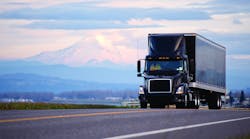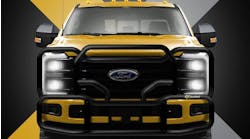If smaller engines are a good fit for your fleet's operations, you could be losing out on savings by spec'ing too big. Along with Fleet Owner's feature examining smaller engines being used in heavy trucks, we got some insight on when fleets can choose smaller engines in the 9-12L range, and what advantages and disadvantages they can expect if they take the plunge.
Here are some comments from Mario Sanchez-Lara, director of on-highway marketing communications at Cummins, and Charles Cook, marketing manager for vocational products at Peterbilt. We asked them questions in four areas regarding smaller engines: (1) trends coming into play, (2) advantages and new technology, (3) applications, and (4) maintenance and resale.
What trends are you seeing with smaller engines?
Sanchez-Lara: "Drivers want more time to spend with their families. In addition, commerce is evolving with online shopping, which is driving the need to have goods ready to ship and deliver to consumers faster. These two mega trends are impacting the transportation model, and there is adoption of a 'hub and spoke' system [i.e., distribution centers or 'hubs' and arterial routes going outward like 'spokes' of a wheel].
"There is also increasing usage of intermodal transportation (rail to trucks, boat to trucks, etc.). These factors are reducing travel distance, and payload is not always maximized. Because of these, the trucks can get the job done with less power to get from point A to point B and back again. This is why the market for smaller engines has grown.
"Regulations and incentives are driving efficiency gains as well. Trucks are becoming more aerodynamic with lower rolling resistance tires, and more fleets are leveraging electronic control features to assist the driver in efficient and safer operation. The cost of equipment has increased significantly, however, driving longer trade cycles and higher durability expectations.
"Here is where the old adage applies: 'There is no replacement for displacement,' which is evident with the broad adoption of engine downspeeding leveraging the higher torque that big bore engines deliver at lower RPMs.
"We at Cummins see more proliferation of truck and trailer configurations that need multiple engine sizes/displacements and multiple types of transmissions to deliver optimized operating efficiency. We anticipate proliferation of optimized vehicle specifications for the very diverse North America on-highway transportation industry."
Cook: "Our dealer networks have a very solutions-based approach to helping customers get the exact spec they need to meet their operational requirements while minimizing their operational costs. Some customers learn they can get the same performance and work done with an 11L engine versus a larger one while gaining improved fuel economy and increased payloads, and it becomes an easy decision to make.
"So it's a trend that has been building, and it's part of a larger approach to spec'ing smarter in general — lightweight components, aerodynamic fairings and driver comfort features, for example.
"Every fleet wants more payload, better fuel economy and improved driver recruiting and retention tools. Getting the spec right can help accomplish of all of these things. Smaller engines are increasingly a significant part of that larger trend."
What advantages can a smaller engine offer? How does technology factor in?
Sanchez-Lara: "Similar to what we have seen in passenger cars, truck engines are adopting dual overhead cams, variable timing, high-pressure common-rail fuel systems, multi-stage turbocharging and sophisticated materials like compacted graphite iron on blocks and head castings.
"All of these technologies bring higher cost as well as increased complexity, which requires comprehensive validation in order to meet reliability expectations. Increased power density vs. durability is a tradeoff between medium-bore and big-bore engines that some are willing to accept."
Cook: "An 11L engine will save weight, improve fuel economy and lower operational costs. If it meets the performance needs for the customer, it makes good business sense.
"That said, it won't always be the right fit — some fleets do need additional power. Our dealers work individually with customers to determine their needs and spec solutions.
"Engine technology is always advancing, and 11L engines today deliver far more horsepower and torque than they did a decade ago. Fleets can realize weight and fuel savings while still getting the performance their drivers want and their routes demand."
What heavy trucking applications could a smaller engine handle?
Sanchez-Lara: "There are a lot of factors that go into choosing the right engine: load size, trip mileage, cruising speeds, geography, elevation, and more importantly, the fleet's performance and durability expectations that derive from its business goal.
"In general terms, 9-13L engines are attractive to fleets that target a lower cost of equipment, more payload and 3-4 year trade cycle and place less importance on residual value. Many fleets continue to opt for big-bore engines above 13L — mostly to leverage power at lower RPMs and harvest the benefits of downspeeding, which are less stress on the engine, better fuel economy and higher residual value."
Cook: "Selecting the right engine for the application is critical. Some considerations include where the truck will be operating, weight of the average load and a long-term view of the total cost of ownership, including resale value.
"We have ongoing training for our staff and our dealers to ensure we are able to help our customers not only choose the best engine for their application but the best overall truck spec to help them be more successful. We approach this as a partnership; our customers must be successful before we can be successful."
What about maintenance and resale with smaller engines?
Sanchez-Lara: "Our medium-bore engines including the ISL9 enjoy preference in the market segment where increased payload is keen. In general, their maintenance intervals are shorter, but the cost of some aspects of it is more cost-effective.
"Smaller engines on big chassis offer lots of space with great serviceability. Cummins products are known for their rugged heavy duty design providing competitive residual value, though not as high as our flagship ISX15 15L."
Cook: "Like the Paccar MX-13 engine, the MX-11 has a rated B10 life of one million miles. This means both those engines are designed and tested so that 90% of the engines produced will reach 1 million mi. without a major overhaul.
"Additionally, from a maintenance standpoint, oil and fuel filter change intervals for the Paccar MX-13 and MX-11 engines have been extended to 60,000 miles for on-highway applications to further reduce operating costs."



